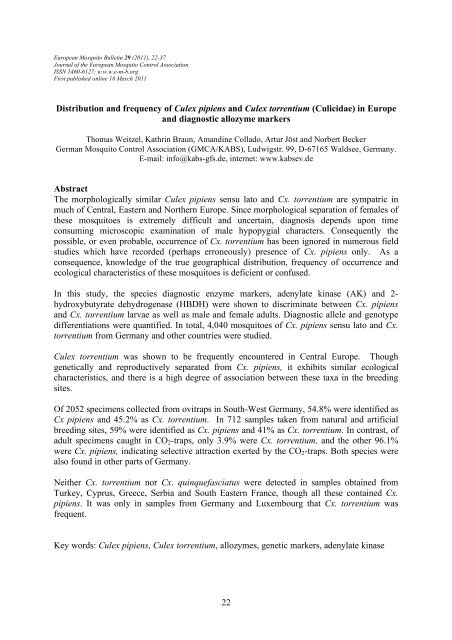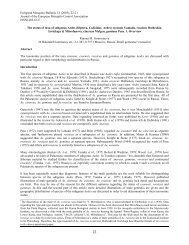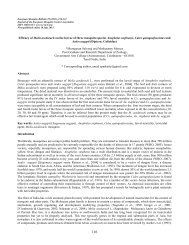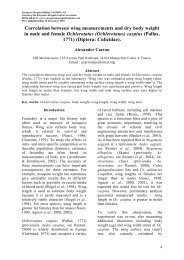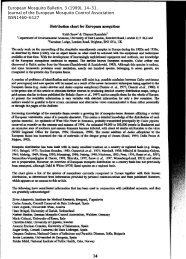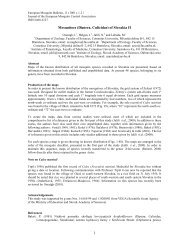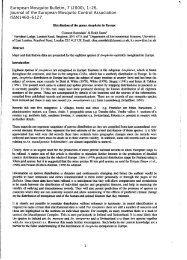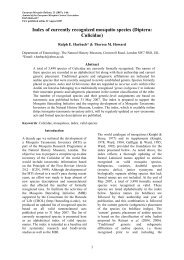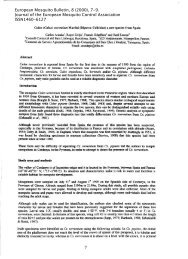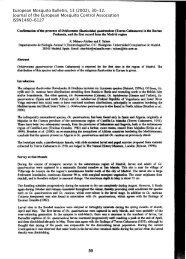22 Distribution and frequency of Culex pipiens and Culex torrentium ...
22 Distribution and frequency of Culex pipiens and Culex torrentium ...
22 Distribution and frequency of Culex pipiens and Culex torrentium ...
Create successful ePaper yourself
Turn your PDF publications into a flip-book with our unique Google optimized e-Paper software.
European Mosquito Bulletin 29 (2011), <strong>22</strong>-37Journal <strong>of</strong> the European Mosquito Control AssociationISSN 1460-6127; w.w.w.e-m-b.orgFirst published online 18 March 2011<strong>Distribution</strong> <strong>and</strong> <strong>frequency</strong> <strong>of</strong> <strong>Culex</strong> <strong>pipiens</strong> <strong>and</strong> <strong>Culex</strong> <strong>torrentium</strong> (Culicidae) in Europe<strong>and</strong> diagnostic allozyme markersThomas Weitzel, Kathrin Braun, Am<strong>and</strong>ine Collado, Artur Jöst <strong>and</strong> Norbert BeckerGerman Mosquito Control Association (GMCA/KABS), Ludwigstr. 99, D-67165 Waldsee, Germany.E-mail: info@kabs-gfs.de, internet: www.kabsev.deAbstractThe morphologically similar <strong>Culex</strong> <strong>pipiens</strong> sensu lato <strong>and</strong> Cx. <strong>torrentium</strong> are sympatric inmuch <strong>of</strong> Central, Eastern <strong>and</strong> Northern Europe. Since morphological separation <strong>of</strong> females <strong>of</strong>these mosquitoes is extremely difficult <strong>and</strong> uncertain, diagnosis depends upon timeconsuming microscopic examination <strong>of</strong> male hypopygial characters. Consequently thepossible, or even probable, occurrence <strong>of</strong> Cx. <strong>torrentium</strong> has been ignored in numerous fieldstudies which have recorded (perhaps erroneously) presence <strong>of</strong> Cx. <strong>pipiens</strong> only. As aconsequence, knowledge <strong>of</strong> the true geographical distribution, <strong>frequency</strong> <strong>of</strong> occurrence <strong>and</strong>ecological characteristics <strong>of</strong> these mosquitoes is deficient or confused.In this study, the species diagnostic enzyme markers, adenylate kinase (AK) <strong>and</strong> 2-hydroxybutyrate dehydrogenase (HBDH) were shown to discriminate between Cx. <strong>pipiens</strong><strong>and</strong> Cx. <strong>torrentium</strong> larvae as well as male <strong>and</strong> female adults. Diagnostic allele <strong>and</strong> genotypedifferentiations were quantified. In total, 4,040 mosquitoes <strong>of</strong> Cx. <strong>pipiens</strong> sensu lato <strong>and</strong> Cx.<strong>torrentium</strong> from Germany <strong>and</strong> other countries were studied.<strong>Culex</strong> <strong>torrentium</strong> was shown to be frequently encountered in Central Europe. Thoughgenetically <strong>and</strong> reproductively separated from Cx. <strong>pipiens</strong>, it exhibits similar ecologicalcharacteristics, <strong>and</strong> there is a high degree <strong>of</strong> association between these taxa in the breedingsites.Of 2052 specimens collected from ovitraps in South-West Germany, 54.8% were identified asCx <strong>pipiens</strong> <strong>and</strong> 45.2% as Cx. <strong>torrentium</strong>. In 712 samples taken from natural <strong>and</strong> artificialbreeding sites, 59% were identified as Cx. <strong>pipiens</strong> <strong>and</strong> 41% as Cx. <strong>torrentium</strong>. In contrast, <strong>of</strong>adult specimens caught in CO 2 -traps, only 3.9% were Cx. <strong>torrentium</strong>, <strong>and</strong> the other 96.1%were Cx. <strong>pipiens</strong>, indicating selective attraction exerted by the CO 2 -traps. Both species werealso found in other parts <strong>of</strong> Germany.Neither Cx. <strong>torrentium</strong> nor Cx. quinquefasciatus were detected in samples obtained fromTurkey, Cyprus, Greece, Serbia <strong>and</strong> South Eastern France, though all these contained Cx.<strong>pipiens</strong>. It was only in samples from Germany <strong>and</strong> Luxembourg that Cx. <strong>torrentium</strong> wasfrequent.Key words: <strong>Culex</strong> <strong>pipiens</strong>, <strong>Culex</strong> <strong>torrentium</strong>, allozymes, genetic markers, adenylate kinase<strong>22</strong>
Introduction<strong>Culex</strong> <strong>pipiens</strong> L. is one <strong>of</strong> the most common <strong>and</strong> widespread Holarctic mosquitoes, with adistribution covering all temperate regions. Two biotypes with many behavioural differencesare present in its Palaearctic distribution, the anautogenous, ornithophic Cx. <strong>pipiens</strong> nominatebiotype, <strong>and</strong> the autogenous, strongly anthropophilic, Cx. <strong>pipiens</strong> molestus biotype. Formerlyregarded as separate taxonomic entities, lack <strong>of</strong> diagnostic morphological characters led tothe current classification. Though regarded as ornithophilic, occasional feeding on humans<strong>and</strong> other mammals has been observed by the nominate biotype (Gingrich & Casillas, 2004,Petric et al., 1999). <strong>Culex</strong> <strong>pipiens</strong> biotype molestus is autogenous <strong>and</strong>, stronglyanthropophilic. Formerly known as Cx. molestus Forskal, the absence <strong>of</strong> reliablemorphological diagnostic characters led to its current taxonomic ranking (Harbach &Harrison, 1984, Becker et al., 2010). The molestus biotype is largely an urban mosquito inthe extensive northern parts <strong>of</strong> its distribution, where it is almost exclusively confined tohypogeal aquatic developmental sites, quite different from the surface or more or less elevatednatural <strong>and</strong> container habitats used by the nominate biotype <strong>of</strong> Cx. <strong>pipiens</strong>The morphologically similar <strong>Culex</strong> <strong>torrentium</strong> Martini occurs in Western Palaearctic regionswhere, due to its close resemblance to Cx. <strong>pipiens</strong>, the situation is confused. The species wasnot described until 1925, a date when mosquito systematics were already well advanced(Harbach et al., 1985). The variable numbers <strong>and</strong> lengths <strong>of</strong> larval setae <strong>and</strong> observeddifferences in egg rafts morphology are not sufficiently diagnostic (Dahl, 1988). Becker et al.(2010) describe differences in the number <strong>of</strong> larval setae with diagnostic relevance, but wellpreserved samples are needed. Almost all morphological characters <strong>of</strong> males are variable <strong>and</strong>overlapping (Dahl, 1988). Mohrig (1969) mentioned differences in wing vein shape, but suchcharacters can only be used by specialists. Morphological differences in the dorsal arms <strong>of</strong>the aedeagus <strong>of</strong> adult males are the only reliable diagnostic characters separating Cx.<strong>torrentium</strong> from Cx. <strong>pipiens</strong> (Mohrig, 1969, Becker et al., 2010).Field studies are difficult when morphological identification <strong>of</strong> species is tedious <strong>and</strong> unsure.Thus knowledge about the quantitative, spatial <strong>and</strong> temporal distribution <strong>of</strong> both species isincomplete <strong>and</strong> they may have been confused in former studies (Vinogradova et al., 2007).These species are not separated in many publications <strong>and</strong> are sometimes h<strong>and</strong>led as bundles<strong>of</strong> “Cx. <strong>pipiens</strong>/<strong>torrentium</strong>” (e.g. Schäfer et al., 2004), or the presumptive existence <strong>of</strong> Cx.<strong>torrentium</strong> seems to have been neglected (e.g. Rydzdanicz & Lonc, 2003), or collectors wereoverwhelmed by high densities <strong>of</strong> Cx. <strong>pipiens</strong>, particularly when females from CO 2 -trapcollections were studied (Petric et al., 1999). Therefore it is essential to consider geneticmarkers.Vector surveys <strong>and</strong> control programmes require separation <strong>of</strong> the clearly ornithophilic Cx.<strong>torrentium</strong> <strong>and</strong> the partially anthropophilic <strong>Culex</strong> <strong>pipiens</strong>. Since West Nile virus outbreaksbecame epidemic in the USA <strong>and</strong> in parts <strong>of</strong> Europe, the zoogeography, taxonomy <strong>and</strong>identification <strong>of</strong> species <strong>of</strong> Cx <strong>pipiens</strong> s.l. <strong>and</strong> related taxa have received high attention.Sindbis virus has been detected recently in a Cx. <strong>torrentium</strong> population in Germany (Jöst etal., 2010). Until it was established experimentally that Cx. <strong>torrentium</strong> was susceptible toSindbis virus in Sweden, Norway <strong>and</strong> Russia, no differentiation <strong>of</strong> Cx. <strong>torrentium</strong> femalesfrom CO 2 -trap catches was made (Lundström, 1994). Ornithophilic mosquito species may actas vectors between bird populations <strong>and</strong> species. Hence the potential <strong>of</strong> arbovirustransmission depends directly on the abundance <strong>of</strong> enzootic vectors. In addition to Cx.<strong>torrentium</strong>, the role <strong>of</strong> the nominate biotype <strong>of</strong> Cx. <strong>pipiens</strong>, has to be taken into consideration,since it has been found to be the most ornithophilic <strong>of</strong> eight common mosquito species, yet23
also feeds on mammals (Gingrich & Williams, 2005). Other mosquito species with catholichost preferences, including the molestus biotype <strong>of</strong> Cx <strong>pipiens</strong>, may serve as bridge vectorsbetween birds <strong>and</strong> man (Medlock et al., 2005, Becker et al., 2010).Molecular techniques have recently been used to discriminate between these <strong>Culex</strong>mosquitoes. Miller et al. (1996) showed by ITS-sequences <strong>of</strong> rDNA, that Cx. <strong>torrentium</strong> isphylogenetically closest to the <strong>Culex</strong> Pipiens Complex. This was confirmed by Weitzel et al.(2009), but considerable genetic distances were measured. Microsatellite-sequences wereanalysed by Smith & Fonseca (2004) <strong>and</strong> variable restriction sites <strong>of</strong> the mitochondrial COIregion were found to be valid for distinction between Cx. <strong>pipiens</strong> <strong>and</strong> Cx. <strong>torrentium</strong>(Shaikevich, 2007, Hesson et al., 2010).Enzyme electrophoretic methods have also been used to discriminate betweenmorphologically similar <strong>Culex</strong> species, e.g. the <strong>Culex</strong> sitiens group (Chapman et al., 2000),four <strong>Culex</strong> species from Florida (Knight & Nayar, 2004), Cx. <strong>pipiens</strong> <strong>and</strong> Cx.quinquefasciatus (Pryor & Daly, 1991, Urbanelli et al., 1995, Cui et al., 2007, Weitzel et al.,2009) <strong>and</strong> between the nominate <strong>and</strong> molestus biotypes <strong>of</strong> Cx. <strong>pipiens</strong> (Lopatin, 1993,Chevillon et al., 1995, Byrne & Nichols, 1999, Weitzel et al., 2009).Urbanelli et al. (1981) found diagnostic enzyme markers (AK-78, AK-100) to distinguishboth species in Italy. Dahl (1988) mentioned allozymic differentiation at three loci betweenSwedish populations <strong>of</strong> Cx. <strong>pipiens</strong> <strong>and</strong> Cx. <strong>torrentium</strong>. Recently, Weitzel et al. (2009)published a comprehensive set <strong>of</strong> allozyme markers to distinguish Cx. <strong>torrentium</strong> frommembers <strong>of</strong> the <strong>Culex</strong> <strong>pipiens</strong> s.l. <strong>and</strong> other <strong>Culex</strong> species. Some <strong>of</strong> these are used in thisstudy.The basis <strong>of</strong> this study was the establishment <strong>of</strong> easily applicable genetic markers fordiagnosis <strong>of</strong> Cx. <strong>pipiens</strong> <strong>and</strong> Cx. <strong>torrentium</strong>, as used by Weitzel et al. (2009). Allele <strong>and</strong>genotype distribution at both AK- <strong>and</strong> HBDH-loci will be described <strong>and</strong> quantified ingeographical populations. Thous<strong>and</strong>s <strong>of</strong> specimens <strong>of</strong> both sexes <strong>and</strong> <strong>of</strong> all developmentalstage from different sources were screened for their species membership <strong>and</strong> correlated withtheir geographic distribution. Additional samples <strong>of</strong> presumptive Cx. <strong>pipiens</strong> (nominatebiotype) / Cx. <strong>torrentium</strong> populations from Turkey, Cyprus, Greece, Serbia, France <strong>and</strong>Luxembourg were assayed. As control taxa for evaluation <strong>of</strong> the genetic markers employed,the anthropophilic molestus biotype <strong>of</strong> Cx. <strong>pipiens</strong> from underground pits <strong>and</strong> Cx.quinquefasciatus from different tropical <strong>and</strong> subtropical regions were employed.The aim <strong>of</strong> the study was to estimate the local occurrence <strong>and</strong> the geographic distribution <strong>of</strong>both Cx <strong>torrentium</strong> <strong>and</strong> the nominate biotype <strong>of</strong> Cx. <strong>pipiens</strong>. Furthermore, the capability <strong>of</strong>CO 2 -traps for representative recording <strong>of</strong> these two mosquitoes was analysed.Materials <strong>and</strong> MethodsMosquito collectionMost Cx. <strong>pipiens</strong> <strong>and</strong> Cx. <strong>torrentium</strong> samples were collected from localities in the UpperRhine Valley, Germany. Three sampling methods were performed <strong>and</strong> the samples werestored in liquid nitrogen until used for enzyme electrophoresis.24
Fig 1. Area <strong>of</strong> sampling by ovitraps, dipping<strong>and</strong> CO 2 -traps in South-West Germany(samples taken from other German <strong>and</strong>European regions not shown)Fig 2. Ovitraps exposed in yards, gardens<strong>and</strong> natural habitats, either containing clearwater or hay infusion.Ovitraps: 96 buckets with black-painted bottoms were used as ovitraps scattered in eightcommunities over the study area in the manner <strong>of</strong> a transect (Fig 1). Each ovitrap contained 2litres <strong>of</strong> either clear rain water or eutrophic hay infusion, (Fig 2). Larvae <strong>and</strong> eggs werecollected from ovitraps every other week, i.e. nine times from May to September 2004, <strong>and</strong>reared to 4 th instar larvae or adulthood. Four buckets were placed in the urban areas, four atthe periphery <strong>of</strong> settlements where garden barrels were frequent, <strong>and</strong> another four in meadows<strong>and</strong> forests. During the two weeks in the ovitrap the larvae developed undisturbed by externalinfluences. After removal <strong>of</strong> the larvae <strong>and</strong> eggs, ovitraps were refilled. Altogether, larvaewere collected from 864 ovitraps during the season.Natural <strong>and</strong> artificial breeding sites in Germany <strong>and</strong> other European countries: In total,samples from 46 different sites in Germany, Western Turkey, Cyprus, Greece, Serbia, SoutheasternFrance <strong>and</strong> Luxembourg were collected by dipping in any type <strong>of</strong> natural <strong>and</strong> artificialbreeding sites <strong>and</strong> sometimes by CO 2 -traps. In urban areas, larvae were collected from barrels<strong>and</strong> open sewage reservoirs. Rural populations came from flood plains, ditches <strong>and</strong> groundpools in forests <strong>and</strong> meadows.Anthropophilic Cx. <strong>pipiens</strong> biotype molestus served as control <strong>and</strong> was collected from fourenclosed underground habitats (cesspits) in different localities in Germany. They were testedfor autogeny by rearing them without a blood meal through two generations (Weitzel et al.,2009). Cx. quinquefasciatus formed another control group <strong>and</strong> were collected in sewagesystems in Luang Prabang, Laos <strong>and</strong> Los Angeles, USA. Additional Cx. quinquefasciatussamples were received from three breeding stocks <strong>of</strong> Bayer CropScience, Monheim,originating from Indonesia <strong>and</strong> Malaysia. They were identified by MDH (NADP) allozymeelectrophoresis (Urbanelli et al., 1997, Weitzel et al., 2009) as well as by examination <strong>of</strong> theanatomy <strong>of</strong> the adult male hypopygia.CO 2 -traps: Presumptive Cx. <strong>pipiens</strong> (nominate biotype) / Cx. <strong>torrentium</strong> adult females wereobtained from 189 CO 2 -trap-collections (Bioquip) for four years from May to Septemberthroughout the study area in Germany (Fig. 1). In 2001 the whole GMCA-area along theRhine River has been sampled <strong>and</strong> between 2002 <strong>and</strong> 2004 identical operations were carried25
out in the Southern part along the French border. The traps were supplied with 1 kg dry ice<strong>and</strong> exposed without light from afternoon until the next morning. In total, 621 Cx. <strong>pipiens</strong> /Cx. <strong>torrentium</strong> individuals were taken from the traps <strong>and</strong> transported on dry ice to thelaboratory.Species identification <strong>and</strong> enzyme electrophoresisA representative selection <strong>of</strong> 62 Cx. <strong>pipiens</strong> <strong>and</strong> 61 Cx. <strong>torrentium</strong> adult males from aboveground breeding sites were identified by hypopygia anatomy (Mohrig, 1969, Dahl, 1988,Becker et al., 2010) on a cooling plate (-10°C). Heads <strong>and</strong> thoraces were removed <strong>and</strong> usedfor allozyme analysis to elaborate the genetic enzyme markers, so ensuring their reliability forthe study (Weitzel et al. 2009).Adenylate kinase (AK, E.C. 2.7.4.3.) <strong>and</strong> 2-hydroxybutyrate dehydrogenase (HBDH, E.C.1.1.1.30) allozymes were used in this study to discriminate between Cx. <strong>torrentium</strong> <strong>and</strong> the Cx<strong>pipiens</strong> biotypes.Sample preparation: Mosquitoes were homogenized by ultrasound (B<strong>and</strong>elin sonopuls GM70) in grinding buffer (10 mM Tris / citric acid, pH 7.5, 10 mM 2-mercaptoethanol) <strong>and</strong>centrifuged for 1 min at 16,000 rpm at 4°C in a Minifuge (eppendorf 5415R). Between 2 <strong>and</strong>4 µl <strong>of</strong> supernatant per sample were used.Electrophoresis: Horizontal thin 1% agarose gels (LEEO, Schreiber & Weitzel, 1995) wererun at 500Vh <strong>and</strong> +4°C in Multiphor II electrophoresis units (LKB Pharmacia).AK: Electrophoresis buffer was prepared with 0.155 M Tris, 0.05 M citric acid, pH 7.0 (250ml for each buffer tank). The corresponding gels were prepared with 90 ml <strong>of</strong> 15.5 mM Tris,5 mM citric acid; pH 7.0.AK is a monomeric enzyme that exhibits amain b<strong>and</strong> with a nongenetic (physiological)sub-b<strong>and</strong> after electrophoresis. Thus,homozygous b<strong>and</strong>ing patterns consist <strong>of</strong> twob<strong>and</strong>s (Fig 3) <strong>and</strong> heterozygous patterns <strong>of</strong>four b<strong>and</strong>s.HBDH: 0.1 M Tris, 0.1 M maleic acid, 0.01Fig 3. AK b<strong>and</strong>ing patternM EDTA <strong>and</strong> 0.01 M MgCl 2 , pH 8.3 (250 ml for each buffer tank) <strong>and</strong> 90 ml <strong>of</strong> 10 mM Tris,10 mM maleic acid, 1 mM EDTA <strong>and</strong> 1 mM MgCl 2 , pH 8.3 for the agarose gel.HBDH is an enzyme with a dimeric molecule structure, producing single b<strong>and</strong>s when itsunderlying gene locus was inheritedhomozygous. Three b<strong>and</strong>s are producedwhen it is heterozygous, with theintermediate b<strong>and</strong> having a double stainingintensity (Fig 4).Staining recipes for AK followed Harris <strong>and</strong>Hopkinson (1976) protocol <strong>and</strong> Murphy etal. (1996) for HBDH.Fig 4. HBDH b<strong>and</strong>ing patternNomenclature <strong>of</strong> allozymes: Enzyme b<strong>and</strong>s were labelled by their relative electrophoreticmobility. The most common allozyme in a Cx. <strong>pipiens</strong> biotype molestus reference populationwas named “100” in relation to its real migration distance. Other allozymes were named withnumbers depending on their electrophoretic mobility relative to the most common allozyme.26
e.g. the observed allozymes <strong>of</strong> AK were called AK-53, AK-78, AK-87, AK-100, AK-124 <strong>and</strong>AK-154, where AK-100 was the most frequent b<strong>and</strong> in the molestus reference population.Genotypic combinations were indicated by the numbers <strong>of</strong> their respective allelecompositions, e.g. AK-100-100 (homozygous) or AK 100-124 (heterozygous).ResultsDetection, application <strong>and</strong> reliability <strong>of</strong> genetic enzyme markersSpecies diagnostic b<strong>and</strong>ing patterns <strong>of</strong> AK <strong>and</strong> HBDH were found to discriminate betweenindividuals <strong>of</strong> Cx. <strong>torrentium</strong> <strong>and</strong> <strong>of</strong> Cx. <strong>pipiens</strong> s.l. The number <strong>of</strong> identified specimens, thegenotype distributions <strong>and</strong> allele frequencies are presented in the appendix, together withcalculations <strong>of</strong> expected genotype frequencies, variances <strong>and</strong> confidence intervals. Eachenzyme system used separately provided sufficient diagnostic value, above 99% <strong>and</strong> up to99.99% when used in combination. In some cases, HBDH staining reactions were too weak tobe reliably read, mostly when larvae samples were used instead <strong>of</strong> adults, which explains whythe number <strong>of</strong> examined specimens with HBDH is lower than with AK. Nevertheless, 4038out <strong>of</strong> 4040 specimens (99.95%) could reliably be diagnosed <strong>and</strong> only 2 (0.05%) specimensremained unidentified.AK genotype combinations specific for Cx. <strong>pipiens</strong> s.l. were found in 99.6% <strong>of</strong> the specimens<strong>of</strong> Cx. <strong>pipiens</strong>. The species specific genotype combination “100-100” was by far the mostfrequent (98.4%). The most common allele “100” was sometimes combined with the rare<strong>pipiens</strong>-alleles, “100-154” (0.28%) <strong>and</strong> “100-124” (0.66%). Other rare combinations were“124-124” (0.24%) <strong>and</strong> “78-124” (0.05%). All these combinations were found to be speciesspecific for Cx. <strong>pipiens</strong>. The combination “78-100” (0.42%) was found rarely in Cx.<strong>torrentium</strong> (Fig 5, Table 4).AK genotypes specific for Cx. <strong>torrentium</strong> were found in 98.9% <strong>of</strong> the specimens. Thegenotype combination “78-78” (88.0%) was the most common. Also the combination “53-78”(10.8%) was frequently found <strong>and</strong> typical for Cx. <strong>torrentium</strong>. The genotypes “78-87”(0.08%) <strong>and</strong> “78-100” (1.14%) were rare.100%100%80%60%40%20%0%Cx. <strong>pipiens</strong>Cx. <strong>torrentium</strong>53-7878-7878-8778-10078-124100-100100-124100-154124-12480%60%40%20%0%Cx. <strong>pipiens</strong>Cx. <strong>torrentium</strong>537887100124154Fig 5. AK genotype distributionFig 6. AK allele frequenciesCalculations <strong>of</strong> expected genotype frequencies, variances <strong>and</strong> confidence intervals <strong>of</strong> allelefrequencies (Table 4, Table 5) demonstrate the high degree <strong>of</strong> reliability <strong>of</strong> the measuredvalues based on the huge sample size <strong>and</strong> the optimized methodology. Deviations at rarevariants are negligible for the purpose <strong>of</strong> species diagnosis. AK-100 was the most frequentallozyme in Cx. <strong>pipiens</strong> (in both the nominate <strong>and</strong> molestus biotypes) <strong>and</strong> in Cx.27
quinquefasciatus, whereas AK-78 <strong>and</strong>, at a lower <strong>frequency</strong> AK-53, were typical inpopulations <strong>of</strong> Cx. <strong>torrentium</strong> (Fig 6, Table 5).Every genotype combination provided 100% confidence in discriminating between Cx.<strong>pipiens</strong> <strong>and</strong> Cx. <strong>torrentium</strong> except “78-100”. However, this genotype was rarely observed(with frequencies <strong>of</strong> 0.33% <strong>and</strong> 0.6% respectively in Cx. <strong>pipiens</strong> <strong>and</strong> Cx. <strong>torrentium</strong>: seeappendix). Analysis with the HBDH marker system confirmed this species diagnosis. If bothenzyme marker systems failed in identifying an individual it was removed from the analysis.HBDH showed a high degree <strong>of</strong> species specific allele <strong>and</strong> genotype distribution <strong>and</strong> wasfound to differentiate between Cx <strong>pipiens</strong> <strong>and</strong> Cx. <strong>torrentium</strong> (Table 6, Table 7). Results fromHBDH served as control <strong>of</strong> the AK-marker. The genotype distribution was as in AK, but witha high degree <strong>of</strong> intraspecific polymorphism <strong>and</strong> heterozygosity <strong>of</strong> individual alleles in Cx.<strong>pipiens</strong>. More than 99% <strong>of</strong> the results <strong>of</strong> HBDH reliably distinguished the species. Thegenotypic <strong>and</strong> allelic differentiation <strong>of</strong> the both species is shown in Fig 7 <strong>and</strong> Fig 8.100%90%80%70%60%50%40%30%20%10%0%Cx. <strong>pipiens</strong>Cx. <strong>torrentium</strong>*-66-2525-2525-10025-158100-100100-158100-<strong>22</strong>5158-158158-<strong>22</strong>5<strong>22</strong>5-<strong>22</strong>5100%80%60%40%20%0%Cx. <strong>pipiens</strong>Cx. <strong>torrentium</strong>-6625100158<strong>22</strong>5Fig 7. HBDH genotype distributionFig 8. HBDH allele frequenciesAbundance <strong>of</strong> Cx. <strong>pipiens</strong> <strong>and</strong> Cx. <strong>torrentium</strong>The 96 ovitraps were employed from mid-May to September. <strong>Culex</strong> sp. larvae were recordedin 442 <strong>of</strong> 864 ovitrap collections in the Upper Rhine Valley (Germany). After rearing thelarvae from 333 ovitraps successfully, 2052 specimens were analysed using allozymeelectrophoresis. This r<strong>and</strong>om selection produced 1124 specimens (54.8%) <strong>of</strong> Cx. <strong>pipiens</strong> (<strong>and</strong>given the open nature <strong>of</strong> their aquatic sources almost certainly <strong>of</strong> the nominate biotype) <strong>and</strong>928 (45.2%) <strong>of</strong> Cx. <strong>torrentium</strong> (Table 1.).The species proportion found in 33 artificial <strong>and</strong> natural breeding sites in the study area wassimilar: Of 420 specimens, (59.0%) were Cx. <strong>pipiens</strong> <strong>and</strong> 292 (41.0%) were Cx. <strong>torrentium</strong>.In contrast to these results from larval populations, CO 2 -traps yielded 597 specimens <strong>of</strong> Cx.<strong>pipiens</strong> (96.1% <strong>of</strong> total catch), but only 24 specimens (3.9%) <strong>of</strong> Cx. <strong>torrentium</strong> (Table 1.).Altogether, 621 specimens <strong>of</strong> both species were caught in 189 traps during four seasons in thestudy area.28
Table 1. Species proportions in 3 sample categories in the Upper Rhine Valley, GermanyTotal Cx. <strong>pipiens</strong> proportion Cx. <strong>torrentium</strong> proportionOvitraps 2052 1124 54.8% 928 45.2%Natural/artificial breeding sites 712 420 59.0% 292 41.0%CO2-traps 621 597 96.1% 24 3.9%Geographic distributionThere was an obvious geographic difference in abundance <strong>of</strong> the two <strong>Culex</strong> species in bothovitraps <strong>and</strong> natural breeding sites (Fig9), with Cx. <strong>torrentium</strong> equally or morefrequent in the northern part <strong>of</strong> thestudy area <strong>and</strong> Cx. <strong>pipiens</strong> predominantin the South. This was not surprising,but is remarkable when the limitedextent <strong>of</strong> the sample area (between thelatitudes <strong>of</strong> 48° <strong>and</strong> 50°) is taken intoaccount.Because assessment <strong>of</strong> seasonalabundance strongly depends on theseasonality <strong>of</strong> the species beingstudied, as well as the location <strong>of</strong> thetraps, the ovitraps were utilised from80%70%60%50%40%30%20%10%0%ovitrapsNorthnatural breed.sites NorthCx. <strong>pipiens</strong>ovitrapsSouthCx. <strong>torrentium</strong>natural breed.sites SouthFig 9. Species proportions in Northern <strong>and</strong>Southern part <strong>of</strong> the study areaMay to September <strong>and</strong> were placed in different type <strong>of</strong> habitats in rural, suburban <strong>and</strong> urbanareas <strong>of</strong> each community. In Table 2 the species proportions in 8 different communitylocations, each with 12 ovitraps, are presented.Table 2. Results <strong>of</strong> collections from ovitraps in the close vicinity <strong>of</strong> different communities insouth-western Germanygeo-coordinates Cx. <strong>pipiens</strong> Cx. <strong>torrentium</strong>location North East number proportion number proportionGernsheim 49°45'1.40"N 8°29'8.95"E 80 35.4% 146 64.6%Waldsee 49°23'45.81"N 8°26'29.39"E 101 48.1% 109 51.9%Ketsch 49°<strong>22</strong>'0.46"N 8°32'0.80"E 112 35.9% 200 64.1%Spechbach 49°20'44.11"N 8°53'5.95"E 125 38.9% 196 61.1%Steinmauern 48°54'1.64"N 8°11'49.31"E 151 75.1% 50 24.9%Freistett 48°40'0.16"N 7°56'29.34"E 143 62.2% 87 37.8%Altenheim 48°27'53.26"N 7°48'34.08"E 263 80.9% 62 19.1%Schwanau 48°23'12.41"N 7°45'19.76"E 149 65.6% 78 34.4%Total 1124 54.8% 928 45.2%29
Both species were also found in other parts <strong>of</strong> Germany, <strong>and</strong> in Luxembourg. <strong>Culex</strong><strong>torrentium</strong> was found only at latitude higher than 48°N. <strong>Culex</strong> <strong>pipiens</strong> from southern France,Serbia, Greece, Turkey <strong>and</strong> Cyprus possessed the same alleles <strong>of</strong> AK <strong>and</strong> HBDH as thosefrom Central Europe, with only slightly different frequencies. (Table 3) MDH (NADP)allozyme analysis did not detect the presence <strong>of</strong> Cx. quinquefasciatus.Table 3. Species records in Mediterranean <strong>and</strong> Central European countriesCountry Location North East source Cx. <strong>pipiens</strong> Cx. <strong>torrentium</strong>Cyprus Nikosia 35°9'38.25"N 33°21'31.61"E sewage plant 7Turkey Izmir 38°25'16.08"N 27°7'47.84"E ovitrap 17Greece Marathon 38°16'2.06"N 24°9'38.30"E container 6Serbia Hajdukovo 46°6'43.97"N 19°49'20.68"E cellar, diapause 21Serbia Novi Sad 45°14'29.87"N 19°50'42.00"E puddle 1France Cressin 45°47'17.20"N 5°46'6.96"E sewage plant 38France St. Désirat 45°15'18.23"N 4°47'7.87"E container 1Luxembourg 4 diff. sites 49°36'N 6°6’E CO 2 trap 7Luxembourg Dondelange 49°41'15.82"N 6°1'47.69"E container 2 10Luxembourg Bous 49°33'43.50"N 6°19'80.90"E CO 2 trap 11 1Germany Weimar 50°58'44.99"N 11°19'27.41"E container 29Germany Fürth 49°28'24.83"N 10°59'27.53"E container 10Germany Munich 48° 8'20.85"N 11°34'48.67"E container 7 3DiscussionThe screening <strong>of</strong> 4040 specimens belonging to the <strong>Culex</strong> <strong>pipiens</strong> s.l. <strong>and</strong> Cx. <strong>torrentium</strong> bythe genetic enzyme markers AK <strong>and</strong> HBDH gave a comprehensive insight into the speciesabundance <strong>and</strong> geographic distribution, <strong>and</strong> also the specific composition <strong>of</strong> CO 2 trapcollections in Central Europe.Most remarkably they showed Cx. <strong>torrentium</strong> to be nearly as frequent <strong>and</strong> widespread as Cx.<strong>pipiens</strong> in the open ground level larval habitats in Germany. Therefore, Cx. <strong>torrentium</strong> shouldalso be considered as one <strong>of</strong> the most abundant mosquito species in Central Europe.Moreover, due to the lack <strong>of</strong> migration barriers, Cx. <strong>torrentium</strong> may be as common as Cx.<strong>pipiens</strong> in other parts <strong>of</strong> Europe with a temperate climate, from northern France to Belgium,The Netherl<strong>and</strong>s, Pol<strong>and</strong>, Ukraine, Baltic States, Russia <strong>and</strong> other areas.Species records depend first <strong>of</strong> all on the choice <strong>of</strong> the correct sampling sites <strong>and</strong> on theseasonal activity <strong>of</strong> the species. Both aspects were taken into account by sampling mosquitoesin various types <strong>of</strong> breeding sites <strong>and</strong> by regularly collecting eggs <strong>and</strong> larvae from ovitrapsthroughout the summer (from May to September). Adjacently located ovitraps containingeither rainwater or hay infusion possibly boosted their efficacy by <strong>of</strong>fering alternatives togravid mosquitoes.30
The number <strong>of</strong> Cx. <strong>torrentium</strong> individuals caught in 189 CO 2 traps (24) was strikingly lowwhen compared to the number Cx. <strong>pipiens</strong> caught (597 individuals) <strong>and</strong> the species wasobviously under-represented. A possible explanation may lie in the st<strong>and</strong>ardised height <strong>of</strong> onemetre above ground (Becker et al. 2010) being too low for strictly ornithophilic mosquitoeslike Cx. <strong>torrentium</strong>, which probably spend their time around nesting zones (Petric et al. 1999).Similar results were obtained by Küpper et al. (2006) who observed an under-representation<strong>of</strong> the number <strong>of</strong> adults <strong>of</strong> both species when using a different trapping system.Until the 1970s, many authors classified Cx. <strong>torrentium</strong> as rare (e.g. Mohrig, 1969), breedingin clear water in natural breeding sites. Moreover, this species was probably <strong>of</strong>ten neglectedor mistakenly classified as Cx. <strong>pipiens</strong>. Later, Struppe (1989) investigated the speciescomposition <strong>of</strong> larval populations from ovitraps <strong>and</strong> natural breeding sites in different urbanzones <strong>of</strong> West-Berlin (North-Eastern Germany). Based solely on the observation <strong>of</strong> adult malehypopygia, Struppe’s study revealed a proportion <strong>of</strong> 52.65% Cx. <strong>torrentium</strong> <strong>and</strong> 47.35% Cx.<strong>pipiens</strong> out <strong>of</strong> 3833 male specimens analysed. 68.1% <strong>of</strong> Cx. <strong>pipiens</strong> <strong>and</strong> 31.9% Cx. <strong>torrentium</strong>came from natural breeding sites whereas 25.2% Cx. <strong>pipiens</strong> <strong>and</strong> 74.8% Cx. <strong>torrentium</strong> camefrom ovitraps. It remains unclear why such differences are observed, <strong>and</strong> it is uncertainwhether or not one can extrapolate Struppe’s results from Berlin to the rest <strong>of</strong> Germany orother parts <strong>of</strong> Europe.Küpper et al. (2006) recorded twice as many Cx. <strong>torrentium</strong> than Cx. <strong>pipiens</strong> from a larvalsurvey in western-Germany. Similar studies in Engl<strong>and</strong>, (Jupp, 1979) found that 62.1% <strong>of</strong> 206samples were Cx. <strong>torrentium</strong>. Also, from collected egg rafts in southern Engl<strong>and</strong>, Gillies &Gubbins (1982) observed proportions <strong>of</strong> 79.7% <strong>and</strong> 83.6% <strong>of</strong> Cx. <strong>torrentium</strong> from one year toanother. In contrast, only 32.6% <strong>and</strong> 24.7%, respectively, <strong>of</strong> male larvae were identified asCx. <strong>torrentium</strong>. However, the British Isl<strong>and</strong>s may not be representative <strong>of</strong> temperatecontinental Europe, due to their special postglacial zoogeographic history. It is well known,that Cx. <strong>torrentium</strong> is ubiquitous in northern Europe (Utrio, 1976, Dahl, 1988, Hesson et al.,2010). In France, <strong>Culex</strong> <strong>torrentium</strong> has been reported in the Pyrenees around 1500m altitudein swampy fields (Sicart, 1954). Moreover, in 1960, Doby & Rault found this species“extremely usual/common” as it was easily sampled in ‘Haute-Savoie’ from a few hundredmeters <strong>of</strong> altitude. More recently, Schaffner (1998) reported the species as being present inFrance <strong>and</strong> Wegner (2009) found Cx. <strong>torrentium</strong> larvae in central Pol<strong>and</strong>. Identifications <strong>of</strong>460 Cx. <strong>pipiens</strong> <strong>and</strong> 321 Cx. <strong>torrentium</strong> were made in a study covering a wide area <strong>of</strong>European Russia (Vinogradova et al., 2007). Both species were detected even at latitudesabove 60°N. However, Cx. <strong>torrentium</strong> was found to be frequent <strong>and</strong> widespread at latitudesabove 50° suggesting that it is ubiquitous at northern rather than southern latitudes.In the present study, investigations <strong>of</strong> mosquito samples from other European countries foundno Cx. <strong>torrentium</strong> were at latitudes below 48°N, where Cx. <strong>pipiens</strong> predominated.Nevertheless Cx. <strong>torrentium</strong> has already been described in several Mediterranean countriessuch as in Italy (Urbanelli et al., 1981) <strong>and</strong> Spain (Ar<strong>and</strong>a et al., 1999). In Turkey, Parrish(1959) found this species only in coastal regions whereas Cx. <strong>pipiens</strong> was widespread.Nicolescu (1998) found both species in the south <strong>of</strong> Romania. In contrast, in the species chart<strong>of</strong> Snow & Ramsdale (1999) Cx. <strong>torrentium</strong> is missing in Bulgaria, Greece, Turkey <strong>and</strong>Mediterranean isl<strong>and</strong>s. Thus it was not likely to be detected by a few hundreds <strong>of</strong> samplescollected at low altitudes in the present study. Nevertheless the allozyme marker systemwould be valid for discrimination <strong>of</strong> Mediterranean Cx. <strong>torrentium</strong> from Cx. <strong>pipiens</strong> s.l.<strong>Culex</strong> quinquefasciatus has not been collected in Greece, Turkey <strong>and</strong> Cyprus (Snow &Ramsdale, 1999; Simsek, 2003). However, Violaris et al. (2009) stated that Cx. <strong>torrentium</strong>31
<strong>and</strong> Cx. quinquefasciatus are absent from Turkey <strong>and</strong> Cyprus, but reported Cx. <strong>pipiens</strong> to beabundant.Success <strong>and</strong> practicability <strong>of</strong> allozyme technique for species diagnosisSpecies diagnostic allele distribution was successfully used for species identification on alarge scale. In this study, AK <strong>and</strong> HBDH allozymes were used in combination to increase theconfidence <strong>of</strong> species identification up to 99.99%. However, the genotype-combination AK-78/100 is the exception as it does not discriminate between Cx. <strong>pipiens</strong> <strong>and</strong> Cx. <strong>torrentium</strong>;but this would only occur at an extremely low percentage (below 1%, see appendix). Becausethe probability <strong>of</strong> finding this genotype in a sampled population is very low, the allozymetechnique is adequate for <strong>Culex</strong> species identification. As a matter <strong>of</strong> fact, two specimens out<strong>of</strong> 4040 (0.05%) possessed the rare genotype AK-78/100 in combination with a weak HBDHstaining reaction, so that only two samples remained unidentified.In addition to their high reliability, both marker systems were shown by Weitzel et al. (2009)to be diagnostic also for Cx. <strong>torrentium</strong> versus Cx. <strong>pipiens</strong> biotype molestus, Cx.quinquefasciatus, Cx. modestus, Cx. territans <strong>and</strong> Cx. stigmatosoma <strong>and</strong> vice versa.Generally, the allozyme technique can be applied to most kinds <strong>of</strong> organisms. The reliability<strong>of</strong> marker systems is obvious by their b<strong>and</strong>ing pattern, <strong>and</strong> is guided by the use <strong>of</strong> referencesamples. The inheritance <strong>of</strong> cytoplasmic enzyme-genes follows Mendelian rules. The allelecombinations (genotypes) are usually readable in the b<strong>and</strong>ing pattern. Accordingly, theHardy-Weinberg equilibrium gives a guideline for the data structure. Thous<strong>and</strong>s <strong>of</strong> base pairs<strong>of</strong> encoding DNA are represented by only a dozen enzyme loci. In case <strong>of</strong> doubt, a sample canbe checked by other differentiated enzyme loci as was demonstrated in this study. Thetechnique is cheap, easy to apply <strong>and</strong> the chemicals are easily available. No toxic substancesare needed, no toxic waste is produced <strong>and</strong> no radiation is emitted. The material costs fordetermination <strong>of</strong> one sample is about 0.30 €, far lower than for a PCR sample. In one day, 88samples were identified using both AK <strong>and</strong> HBDH marker systems with 44 samples per gel.A higher efficiency is possible, especially when only AK is used <strong>and</strong> in consequence a 1%portion <strong>of</strong> junk is acceptable. This procedure allows huge sample sizes. For each run in thinagarose gels, about 10% <strong>of</strong> the body <strong>of</strong> a mosquito is needed, thus in vector studies thesamples can be divided <strong>and</strong> one part <strong>of</strong> the mosquitoes used for electrophoresis, the other partfor further processing. The preparation process <strong>and</strong> conduction <strong>of</strong> the protein electrophoresisinvolves common laboratory practice easily performed by a technician or a student. In the lastdecades the technique has been optimized to a higher degree <strong>of</strong> efficiency <strong>and</strong> the dataevaluation computerized. A large amount <strong>of</strong> data is available for comparison.AcknowledgementsThanks are due to the German Mosquito Control Association (GMCA/KABS) <strong>and</strong>Gesellschaft zur Förderung der Stechmückenbekämpfung (GFS) for financial support. We arevery grateful to Matthias Beck (Germany, USA), Wolf-Peter Pfitzner, Achim Kaiser <strong>and</strong>Andreas Arnold (Germany), Marija Zgomba <strong>and</strong> Duşan Petrić, University <strong>of</strong> Novi Sad,Serbia, <strong>and</strong> Delphine Rey <strong>and</strong> Rémi Foussadier, EID Rhône Alpes, France for the collection<strong>of</strong> mosquito samples. Specimens <strong>of</strong> Cx quinquefasciatus from Malaysia <strong>and</strong> Indonesia wereprovided by Bayer CropScience, Monheim, Germany. We thank Klaus H<strong>of</strong>fmann <strong>and</strong> KerstinPietsch for technical assistance.ReferencesAr<strong>and</strong>a, C., Eritja, R., Schaffner, F. & Escosa, R. (2000) <strong>Culex</strong> (<strong>Culex</strong>) <strong>torrentium</strong> Martini(Diptera, Culicidae) a new species from Spain. European Mosquito Bulletin 8, 7-9.32
Byrne, K. & Nichols, R.A. (1999) <strong>Culex</strong> <strong>pipiens</strong> in London Underground tunnels:differentiation between surface <strong>and</strong> subterranean populations Heredity 82, 7-15.Becker, N., Petrić, D., Zgomba, M., Boase, C., Dahl, C., Lane, J. & Kaiser, A. (2003, 2010)Mosquitoes <strong>and</strong> their control. 1 st <strong>and</strong> 2 nd ed. Kluwer Academic / Plenum Publishers,New York.Chapman, H.F., Kay, B.H., Ritchie, S.A., van den Hurk, A.F. & Hughes, J.M. (2000)Definition <strong>of</strong> Species in the <strong>Culex</strong> sitiens Subgroup (Diptera: Culicidae) from PapuaNew Guinea <strong>and</strong> Australia. Journal <strong>of</strong> Medical Entomology 37, 736-742.Chevillon, C., Eritja, R., Pasteur, N. & Raymond, M. (1995) Commensalism, adaption <strong>and</strong>gene flow: mosquitoes from the <strong>Culex</strong> <strong>pipiens</strong> complex in different habitats. GeneticalResearch 66, 147-157.Cui F., Qiao, C.-L., Shen, B.-C., Marquine, M., Weil M. & Raymond M. (2007) Geneticdifferentiation <strong>of</strong> <strong>Culex</strong> <strong>pipiens</strong> (Diptera: Culicidae) in China. Bulletin <strong>of</strong>Entomological Research 97, 291–297.Dahl, C. (1988) Taxonomic studies on <strong>Culex</strong> <strong>pipiens</strong> <strong>and</strong> Cx. <strong>torrentium</strong>. Pp 149-175 in:Service, M.W. (ed.), Biosystematics <strong>of</strong> Haematophagous Insects. Clarendon Press,Oxford.Doby, J.M. & Rault, B. (1960) Complément à l'étude des caractères morphologiquesdifférentiels de <strong>Culex</strong> <strong>pipiens</strong> Linné, 1758 et de <strong>Culex</strong> <strong>torrentium</strong> Martini, 1924(Diptera Culicidae). Cahiers des Naturalistes, nouvelle série 16, 113-1<strong>22</strong>.Gillies, M.T. & Gubbins, S.J. (1982) <strong>Culex</strong> (<strong>Culex</strong>) <strong>torrentium</strong> Martini <strong>and</strong> Cx. <strong>pipiens</strong> (L.) ina Southern English County, 1974-1975. Mosquito Systematics 14, 127-130.Gingrich, J.B. & Casillas, L.J. (2004) Selected mosquito vectors <strong>of</strong> West Nile virus:comparison <strong>of</strong> their ecological dynamics in four woodl<strong>and</strong> <strong>and</strong> marsh habitats inDelaware. Journal <strong>of</strong> the American Mosquito Control Association 20, 138-145.Gingrich, J.B. & Williams, G.M. (2005) Host-feeding patterns <strong>of</strong> suspected West Nile virusmosquito vectors in Delaware, 2001-2002. Journal <strong>of</strong> the American Mosquito ControlAssociation 21, 194-200.Harbach, R.E. & Harrison, A.M. (1984) <strong>Culex</strong> (<strong>Culex</strong>) molestus Forskảl (Diptera: Culicidae):Neotype designation, description, variation, <strong>and</strong> taxonomic status. Proceedings <strong>of</strong> theEntomological Society <strong>of</strong> Washington 86, 521-542.Harbach, R.E., Dahl, C. & White, G. (1985) <strong>Culex</strong> (<strong>Culex</strong>) <strong>pipiens</strong> Linnaeus (Diptera:Culicidae): concepts, type designations, <strong>and</strong> description. Proceedings <strong>of</strong> theEntomological Society <strong>of</strong> Washington 87, 1-24.Harris, H. & Hopkinson, D.A. (1976) H<strong>and</strong>book <strong>of</strong> enzyme electrophoresis in humangenetics. North Holl<strong>and</strong> Publishers Company, Amsterdam, Oxford.Hesson, J., Lundström, J., Halvarsson, P., Erixon, P. & Collado, A. (2010) A sensitive <strong>and</strong>reliable restriction enzyme method to distinguish between <strong>Culex</strong> <strong>torrentium</strong> <strong>and</strong> <strong>Culex</strong><strong>pipiens</strong> (Diptera: Culicidae). Medical Veterinary Entomology 24, 142-149.Jöst, H., Bialonski A., Storch V., Günther S., Becker N. & Schmidt-Chanasit J. (2010)Isolation <strong>and</strong> phylogenetic analysis <strong>of</strong> Sindbis viruses from mosquitoes in Germany.Journal <strong>of</strong> Clinical Microbiology 48, 1900-3.Jupp, P.G. (1979) <strong>Culex</strong> (<strong>Culex</strong>) <strong>pipiens</strong> <strong>and</strong> Cx. <strong>torrentium</strong> (Diptera: Culicidae) in Engl<strong>and</strong>:Notes on their Taxonomy <strong>and</strong> Biology. Mosquito Systematics 11, 121.Knight, J.W. & Nayar, J.K. (2004). Identification <strong>of</strong> four commom <strong>Culex</strong> (<strong>Culex</strong>)(Diptera:Culicidae) species from Florida with isoenzyme analysis. FloridaEntomologist 87, 1-5.Küpper, S., Schulze, S., Maier, W.A. & Kampen, H. (2006) Beitrag zum Vorkommen und zurVerbreitung von Stechmücken (Diptera: Culicidae) in Nordrheinwestfalen mitbesonderer Berücksichtigung des Großraums Bonn. Mitteilungen der DeutschenGesellschaft für Allgemeine und Angew<strong>and</strong>te Entomologie 15, 337-344.33
Lopatin, O.E. (1993) On the genetic structure <strong>of</strong> anthropophilous populations <strong>of</strong> <strong>Culex</strong><strong>pipiens</strong>. Krovososushchiye dvukrylyye, 82-85.Lundström, J.O. (1994) Vector competence <strong>of</strong> Western European mosquitoes for arboviruses:a review <strong>of</strong> field <strong>and</strong> experimental studies. Bulletin <strong>of</strong> the Society <strong>of</strong> Vector Ecology19, 23-36.Medlock, J.M., Snow K.R. & Leach, S. (2005) Potential transmission <strong>of</strong> West Nile virus inthe British Isles: an ecological review <strong>of</strong> c<strong>and</strong>idate mosquito bridge vectors. Medical<strong>and</strong> Veterinary Entomology 19, 2-21.Miller, B.R., Crabtree, M.B. & Savage H.M. (1996) Phylogeny <strong>of</strong> fourteen <strong>Culex</strong> mosquitospecies, including the <strong>Culex</strong> <strong>pipiens</strong> complex, inferred from the internal transcribedspacers <strong>of</strong> ribosomal DNA. Insect Molecular Biology 5, 93-107.Mohrig, W. (1969) Die Culiciden Deutschl<strong>and</strong>s. Parasitologische Schriftenreihe 18, 260 pp.Murphy, R.W., Sites, J.W., Buth, D.G. & Haufler, C.H. (1996) Proteins: IsozymeElectrophoresis. In: Molecular Systematics 2 nd ed. (Hillis, D.M., Moritz, C. & Mable,B.K.). Sinauer Associates, Sunderl<strong>and</strong>, Massachusettes, USA, 51-120.Nicolescu, G. (1998) A general characterisation <strong>of</strong> the mosquito fauna (Diptera: Culicidae) inthe epidemic area for West Nile virus in the south <strong>of</strong> Romania. European MosquitoBulletin 2, 13-18.Parrish, D.W. (1959) The Mosquitoes <strong>of</strong> Turkey. Mosquito News 19, 264-266.Petrić, D., Zgomba, M. Bellini, R., Veronesi, R., Kaiser, A. & Becker, N. (1999) Validation<strong>of</strong> CO 2 Trap Data in three European Regions. Proceedings <strong>of</strong> the 3 rd InternationalConference on Urban Pests, 437-445.Pryor, S.C. & Daly, J. (1991) Temporal Variation in morphological <strong>and</strong> genetic characteristicswithin a hybrid population <strong>of</strong> <strong>Culex</strong> <strong>pipiens</strong> (Diptera: Culicidae). Journal <strong>of</strong> MedicalEntomology 28, 481-486.Rydzdanicz, K. & Lonc, E. (2003) Species composition <strong>and</strong> seasonal dynamics <strong>of</strong> mosquitolarvae in the Wroclaw, Pol<strong>and</strong> area. Journal <strong>of</strong> Vector Ecology. 28, 255-266.Schreiber, A. & Weitzel, T. (1995) Biochemical Systematics <strong>of</strong> Sea Eagles (Genus HaliaeetusSavigny 1809), with a Note on Allozyme Differentiation Between Black <strong>and</strong> RedKites (Genus Milvus L. 1758). Biochemical Systematics <strong>and</strong> Ecology 23, 235-244.Schäfer, M.L., Lundström, J.O., Pfeffer, M., Lundkvist, E. & Ladin, J. (2004) Biologicaldiversity versus risk for mosquito nuisance <strong>and</strong> disease transmission in constructedwetl<strong>and</strong>s in southern Sweden. Medical <strong>and</strong> Veterinary Entomology 18, 256-267.Schaffner, F. (1998) A revised checklist <strong>of</strong> the French Culicidae. European Mosquito Bulletin2, 1-9.Shaikevich, E.V. (2007) PCR-RFLP <strong>of</strong> the COI gene reliably differentiates Cx. <strong>pipiens</strong>, Cx.<strong>pipiens</strong> f. molestus <strong>and</strong> Cx. <strong>torrentium</strong> <strong>of</strong> the Pipiens Complex. European MosquitoBulletin 23, 25-30.Sicart, M. (1954) Présence de <strong>Culex</strong> <strong>torrentium</strong> dans les Pyrénées et comparaisons avec <strong>Culex</strong><strong>pipiens</strong> du même gite. Societé d'Histoire Naturelle de Toulouse Bulletin 89, <strong>22</strong>8-230.Simsek, F.M. (2003) Seasonal Population Dynamics <strong>and</strong> Breeding Habitat Diversity <strong>of</strong> <strong>Culex</strong><strong>pipiens</strong> Linnaeus, 1758 (Diptera: Culicidae) in Gölbasi District, Ankara, Turkey.Journal <strong>of</strong> the Society for Entomological Research 5, 51-62.Smith, J.L. & Fonseca, D.M. (2004) Rapid assay for identification <strong>of</strong> members <strong>of</strong> the <strong>Culex</strong>(<strong>Culex</strong>) <strong>pipiens</strong> complex, their hybrids, <strong>and</strong> other sibling species (Diptera: Culicidae).American Journal for Tropical <strong>and</strong> Medical Hygiene 70, 339-345.Snow, K. <strong>and</strong> Ramsdale, C. (1999) <strong>Distribution</strong> chart for European mosquitoes. EuropeanMosquito Bulletin 3, 14-31.Struppe, Th. (1989) Biologie und Ökologie von <strong>Culex</strong> <strong>torrentium</strong> (Martini) unter besondererBerücksichtigung seiner Beziehungen im menschlichen Siedlungsbereich. Angew<strong>and</strong>teZoologie 17, 257-86.34
Urbanelli, S., Cianchi, R., Petrarca, V., Sabatinelli, M., Colluzzi, M. & Bullini, L. (1981)Adattamento all'ambiente erbano nella zanzara <strong>Culex</strong> <strong>pipiens</strong> (Diptera: Culicidae). In:Moroni, A., Ravera, O., Anelli, A. (eds.) Ecologia, Atti XI Congressi nazionali.Societa Italiana E. Zara, Parma. 305-316.Urbanelli, S., Silvestrini, F., Sabatinelli, G., Ravelorifera, F., Petrarca, V. & Bullini, L. (1995)Characterization <strong>of</strong> the <strong>Culex</strong> <strong>pipiens</strong> Complex (Diptera: Culicidae) in Madagascar.Journal <strong>of</strong> Medical Entomology 32, 778-786.Urbanelli, S., Silvestrini, F., Reisen, W. K., De Vito, E. & Bullini, L. (1997) Californianhybrid zone between <strong>Culex</strong> <strong>pipiens</strong> <strong>pipiens</strong> <strong>and</strong> Cx. p. quinquefasciatus revisited(Diptera: Culicidae). Journal <strong>of</strong> Medical Entomology 34, 116-127.Utrio, P. (1976) Identification Key to Finnish Mosquito Larvae (Diptera, Culicidae). AnnalesAgriculturar Fenniae 15, 128 -136.Vinogradova, E.B., Shaikevich, E.V. & Ivanitsky, A.V. (2007) A study <strong>of</strong> the distribution <strong>of</strong>the <strong>Culex</strong> <strong>pipiens</strong> complex (Insecta: Diptera: Culicidae) mosquitoes in the Europeanpart <strong>of</strong> Russia by molecular methods <strong>of</strong> identification. Comparative Cytogenetics 1,129-138.Violaris, M., Vasquez, M.I., Samanidou, A., Wirth, M.C. & Hadjivassilis, A. (2009) Themosquito fauna <strong>of</strong> the republic <strong>of</strong> Cyprus: a revised list. Journal <strong>of</strong> the AmericanMosquito Control Association 25, 199-202.Wegner, E. (2009) A study <strong>of</strong> mosquito fauna (Diptera: Culicidae) <strong>and</strong> the phenology <strong>of</strong> thespecies recorded in Wilanów (Warsaw, Pol<strong>and</strong>). European Mosquito Bulletin 27, 23-32.Weitzel, T., Collado, A., Jöst, A., Pietsch, K., Storch, V. & Becker, N. (2009) Geneticdifferentiation <strong>of</strong> populations within the <strong>Culex</strong> Pipiens Complex (Diptera: Culicidae)<strong>and</strong> phylogeny <strong>of</strong> related species. Journal <strong>of</strong> the American Mosquito ControlAssociation 25, 6-17.35
AppendixDetails <strong>of</strong> genotype <strong>and</strong> allele frequencies <strong>of</strong> adenylate kinase <strong>and</strong> 2-hydroxybutyratedehydrogenase <strong>and</strong> the respective number <strong>of</strong> mosquito specimens are presented. Calculations<strong>of</strong> expected genotype frequencies following Hardy-Weinberg equilibrium, <strong>and</strong> the variances<strong>and</strong> confidence intervals <strong>of</strong> allele frequencies give an idea <strong>of</strong> the reliability <strong>of</strong> the data.Table 4. AK genotype distribution in German Cx. <strong>pipiens</strong>, Cx. <strong>torrentium</strong> <strong>and</strong> control taxaAK genotypesSpecies Total 53-78 78-78 78-87 78-100 78-124 100-100 100-124 100-154 124-124Cx. <strong>pipiens</strong> number 2133 0 0 0 7 1 2101 13 6 5<strong>frequency</strong> 0.0000 0.0000 0.0000 0.0033 0.0005 0.9850 0.0061 0.0028 0.0023frequ. expected 0.0000 0.0000 0.0000 0.0037 0.0000 0.9823 0.0112 0.0028 0.0000Cx. <strong>torrentium</strong> number 1236 142 1085 1 8 0 0 0 0 0<strong>frequency</strong> 0.1149 0.8778 0.0008 0.0065 0.0000 0.0000 0.0000 0.0000 0.0000frequ. expected 0.1079 0.8816 0.0008 0.0061 0.0000 0.0000 0.0000 0.0000 0.0000Cx. <strong>pipiens</strong> number 180 0 0 0 0 0 179 0 1 0biot. molestus<strong>frequency</strong> 0.0000 0.0000 0.0000 0.0000 0.0000 0.9944 0.0000 0.0056 0.0000frequ. expected 0.0000 0.0000 0.0000 0.0000 0.0000 0.9945 0.0000 0.0055 0.0000Cx. quinque- number 181 0 0 0 0 0 178 3 0 0fasciatus<strong>frequency</strong> 0.0000 0.0000 0.0000 0.0000 0.0000 0.9834 0.0166 0.0000 0.0000frequ. expected 0.0000 0.0000 0.0000 0.0000 0.0000 0.9835 0.0164 0.0000 0.0001Table 5. AK allele distribution in Cx. <strong>pipiens</strong>, Cx. <strong>torrentium</strong> <strong>and</strong> control taxaAK allelesSpecies Total 53 78 87 100 124 154Cx. <strong>pipiens</strong> number (2n) 4266 0 8 0 4<strong>22</strong>8 24 6<strong>frequency</strong> 0.0000 0.0019 0.0000 0.9911 0.0056 0.0014variance 0.0000 0.0000 0.0000 0.0000 0.0000 0.0000confidence (+/-) 0.0000 0.0013 0.0000 0.0029 0.0023 0.0011Cx. <strong>torrentium</strong> number (2n) 2472 142 2321 1 8 0 0<strong>frequency</strong> 0.0574 0.9389 0.0004 0.0032 0.0000 0.0000variance 0.0000 0.0000 0.0000 0.0000 0.0000 0.0000confidence (+/-) 0.0094 0.0096 0.0008 0.0023 0.0000 0.0000Cx. <strong>pipiens</strong> number (2n) 360 0 0 0 359 0 1biotype. molestus <strong>frequency</strong> 0.0000 0.0000 0.0000 0.9972 0.0000 0.0028variance 0.0000 0.0000 0.0000 0.0000 0.0000 0.0000confidence (+/-) 0.0000 0.0000 0.0000 0.0055 0.0000 0.0055Cx. quinquefasciatus number (2n) 362 0 0 0 359 3 0<strong>frequency</strong> 0.0000 0.0000 0.0000 0.9917 0.0083 0.0000variance 0.0000 0.0000 0.0000 0.0000 0.0000 0.0000confidence (+/-) 0.0000 0.0000 0.0000 0.0095 0.0095 0.000036
Table 6. HBDH genotype distribution in German Cx. <strong>pipiens</strong>, Cx. <strong>torrentium</strong> <strong>and</strong> control taxaHBDH genotypesSpecies Total -66--66 -66-25 25-25 25-100 25-158 100-100 100-158 100-<strong>22</strong>5 158-158 158-<strong>22</strong>5 <strong>22</strong>5-<strong>22</strong>5Cx. <strong>pipiens</strong> number 1647 0 5 264 733 1 641 0 0 2 0 1<strong>frequency</strong> 0.0000 0.0030 0.1603 0.4451 0.0006 0.3892 0.0000 0.0000 0.0012 0.0000 0.0006frequ. exp. 0.0000 0.0012 0.1479 0.4706 0.0012 0.3742 0.0019 0.0007 0.0000 0.0000 0.0000Cx.<strong>torrentium</strong> number 957 0 0 0 1 0 21 23 1 838 67 6<strong>frequency</strong> 0.0000 0.0000 0.0000 0.0010 0.0000 0.0219 0.0240 0.0010 0.8757 0.0700 0.0063frequ. exp. 0.0000 0.0000 0.0000 0.0000 0.0010 0.0012 0.0646 0.0029 0.8513 0.0771 0.0017Cx. <strong>pipiens</strong> number 68 0 0 0 20 0 48 0 0 0 0 0biotypemolestus <strong>frequency</strong> 0.0000 0.0000 0.0000 0.2941 0.0000 0.7059 0.0000 0.0000 0.0000 0.0000 0.0000frequ. exp. 0.0000 0.0000 0.0216 0.2509 0.0000 0.7275 0.0000 0.0000 0.0000 0.0000 0.0000Cx. quinque- number 102 1 13 87 0 0 0 0 0 1 0 0fasciatus <strong>frequency</strong> 0.0098 0.1275 0.8529 0.0000 0.0000 0.0000 0.0000 0.0000 0.0098 0.0000 0.0000frequ. exp. 0.0054 0.1348 0.8403 0.0000 0.0180 0.0000 0.0000 0.0000 0.0001 0.0000 0.0000Table 7. HBDH allele frequencies. variances <strong>and</strong> confidence intervalsHBDH allelesSpecies Total -66 25 100 158 <strong>22</strong>5Cx. <strong>pipiens</strong> number (2n) 3328 5 1282 2033 6 2<strong>frequency</strong> 0.0015 0.3852 0.6109 0.0018 0.0006variance 0.0000 0.0001 0.0001 0.0000 0.0000confidence (+/-) 0.0013 0.0169 0.0169 0.0015 0.0008Cx. <strong>torrentium</strong> number (2n) 1968 0 1 68 1816 83<strong>frequency</strong> 0.0000 0.0005 0.0346 0.9<strong>22</strong>8 0.04<strong>22</strong>variance 0.0000 0.0000 0.0000 0.0000 0.0000confidence (+/-) 0.0000 0.0010 0.0082 0.0120 0.0091Cx. <strong>pipiens</strong> biotype number (2n) 244 0 33 211 0 0molestus <strong>frequency</strong> 0.0000 0.1352 0.8648 0.0000 0.0000variance 0.0000 0.0005 0.0005 0.0000 0.0000confidence (+/-) 0.0000 0.0438 0.0438 0.0000 0.0000Cx. quinquefasciatus number (2n) 238 15 <strong>22</strong>1 0 2 0<strong>frequency</strong> 0.0630 0.9286 0.0000 0.0084 0.0000variance 0.0002 0.0003 0.0000 0.0000 0.0000confidence (+/-) 0.0315 0.0334 0.0000 0.0118 0.000037


